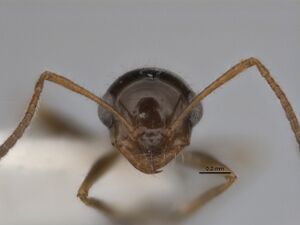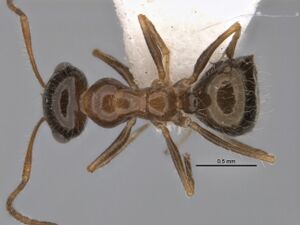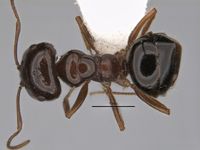Melophorus ankylochaetes
| Melophorus ankylochaetes | |
|---|---|

| |
| Scientific classification | |
| Kingdom: | Animalia |
| Phylum: | Arthropoda |
| Class: | Insecta |
| Order: | Hymenoptera |
| Family: | Formicidae |
| Subfamily: | Formicinae |
| Tribe: | Melophorini |
| Genus: | Melophorus |
| Species group: | biroi |
| Species complex: | fieldi |
| Species: | M. ankylochaetes |
| Binomial name | |
| Melophorus ankylochaetes Heterick, Castalanelli & Shattuck, 2017 | |
Ecological data are lacking, but the ant has been found in boxpine scrub over red soil (QLD) and foraging on the ground in mallee (WA).
Identification
Heterick et al. (2017) - Melophorus ankylochaetes can be placed in the Melophoprus biroi species-group on the basis of characters of the clypeus, propodeum, mandible and palps. The species is also placed in the Melophoprus fieldi species-complex because of the appearance of the anteriorly placed clypeal psammophore, the compact propodeum, the presence of more than one preapical spine on the metatibia, at least in the major worker, the long, even spindly legs, and the unmodified mandible in the major worker. Furthermore, this species clusters with several others in the M. fieldi complex which share the following characters: gaster with curved erect setae, semi-erect setae and a few decumbent setae only, genuine appressed setae lacking; the body generally strongly sculptured and hirsute and the antennal scapes and legs with whorls of many fine, straight setae. Melophorus ankylochaetes is distinguishable from Melophorus incisus as the mesonotum and propodeum are not globose; the mesonotum being separated from the mesopleuron and propodeum by a weak groove or indentation. Melophorus ankylochaetes can also be distinguished from populations of Melophorus hirsutipes with the ‘pillipes’ condition (whorls of fine, erect setae on appendages) because of the narrow, squamiform petiolar node of major and media workers (when viewed in profile) and the shiny appearance of the head (more matt and even rugulose in M. hirsutipes). The minor worker is not so distinctive, but can still be separated from the minor worker of M. hirsutipes (“pillipes”) by the more shining appearance of the head and anterior mesosoma and by its rounded propodeum.
Unlike some related taxa, Melophorus ankylochaetes is easy to characterize as a shining and very hairy Melophorus, with many fine, flexuous setae on the body, curved erect and suberect setae only on the first gastral tergite and whorls of ‘pillipes’- type setae on the tibiae. Populations of the ant without the ‘pillipes’ condition may occur (given its position within the M. fieldi complex), but the other characters mentioned should still enable specimens to be recognized. Genetic sequencing strongly supports this species as a sister to Melophorus incisus (which has a similar vestiture on the gaster) within the M. fieldi complex, but M. ankylochaetes does not have such deep sulci between the mesosomal anatomical regions (e.g., especially the anepisternum and katepisternum).
Distribution
Melophorus ankylochaetes has a broad distribution in the northern states (NSW, NT, QLD and WA) and probably also occurs in northern SA, but is unlikely to be found in Victoria or Tasmania. (Heterick et al. 2017)
Distribution based on Regional Taxon Lists
Australasian Region: Australia (type locality).
Distribution based on AntMaps
Distribution based on AntWeb specimens
Check data from AntWeb
Countries Occupied
| Number of countries occupied by this species based on AntWiki Regional Taxon Lists. In general, fewer countries occupied indicates a narrower range, while more countries indicates a more widespread species. |

|
Estimated Abundance
| Relative abundance based on number of AntMaps records per species (this species within the purple bar). Fewer records (to the left) indicates a less abundant/encountered species while more records (to the right) indicates more abundant/encountered species. |

|
Biology
Castes
Worker
   
| |
| Worker (minor). . | |
Phylogeny
| Melophorus |
| ||||||||||||||||||||||||||||||||||||
Based on Heterick et al., 2017. Only selected species groups/complexes are included.
Nomenclature
The following information is derived from Barry Bolton's Online Catalogue of the Ants of the World.
- ankylochaetes. Melophorus ankylochaetes Heterick, Castalanelli & Shattuck, 2017: 231, fig. 52 (w.) AUSTRALIA.
Unless otherwise noted the text for the remainder of this section is reported from the publication that includes the original description.
Description
Worker
(n = 6): CI 101–126; EI 19–38; EL 0.20–0.33; HL 0.51–1.39; HW 0.52–1.76; ML 0.71-.1.71; MTL 0.43–1.12; PpH 0.07–0.20; PpL 0.27–0.65; SI 63–118; SL 0.61–1.12.
Minor. Head. Head square; posterior margin of head weakly convex; frons striolate anteriad, smooth and shining posteriad; pilosity of frons a mixture of short, erect and semi-erect setae interspersed with shorter decumbent setae and well-spaced, short, appressed setae. Eye moderate (eye length 0.20–0.49 length of side of head capsule); in full-face view, eyes set at about midpoint of head capsule; in profile, eye set anteriad of midline of head capsule; eyes elliptical or slightly reniform. In full-face view, frontal carinae straight or weakly convex; frontal lobes straight in front of antennal insertion. Anteromedial clypeal margin convex, weakly acuminate anteromedially; clypeal psammophore set at or above midpoint of clypeus; palp formula 6,4. Five mandibular teeth in minor worker; mandibles triangular, weakly incurved; third mandibular tooth distinctly shorter than apical tooth and teeth numbers two and four; masticatory margin of mandibles approximately vertical or weakly oblique. Mesosoma. Integument of pronotum, mesonotum and mesopleuron shining and mainly smooth, vestigial shagreenation most noticeable on humeri and mesopleuron; anterior mesosoma in profile smoothly rounded anteriad, thereafter pronotum and whole of mesonotum flattened and on same plane as propodeum; appearance of erect pronotal setae long (i.e., longest erect setae longer than length of eye) and unmodified; in profile, metanotal groove a narrow but deep slit; propodeum shining, with multiple hair like striolae, or shining and uniformly striolate; propodeum smoothly rounded or with indistinct angle; propodeal dorsum and declivity confluent; erect propodeal setae present and abundant (greater than 12); appressed propodeal setulae long and separated by at least own length; propodeal spiracle situated on or beside declivitous face of propodeum, and shorter (length < 0.50 × height of propodeum). Petiole. In profile, petiolar node squamiform; in full-face view, shape of petiolar node uniformly rounded; node shining and smooth throughout. Gaster. Gaster smooth and glossy; pilosity of first gastral tergite consisting wholly or mainly of long, curved setae, appressed setae apparently absent. General characters. Colour mainly foreparts russet with gaster blackish-brown; more rarely concolorous blackish-brown.
Major. Head. Head horizontally rectangular, broader than wide; posterior margin of head weakly concave; cuticle of frons shining and smooth except for piliferous pits and a few striolae around antennal insertion sand frontal carinae; pilosity of frons a mixture of well-spaced, distinctly longer erect and semi-erect setae interspersed with shorter decumbent setae. Eye moderate (eye length 0.20–0.49 length of head capsule); in full-face view, eyes set at about midpoint of head capsule; in profile, eye set anteriad of midline of head capsule; eyes elliptical. In full-face view, frontal carinae straight, divergent posteriad; frontal lobes straight in front of antennal insertion. Anterior clypeal margin broadly convex with anteromedial dimple; clypeal psammophore set at or above midpoint of clypeus; palp formula 6,4. Five mandibular teeth in major worker; mandibles triangular, weakly incurved; third mandibular tooth distinctly shorter than apical tooth and teeth numbers two and four, or absent; masticatory margin of mandibles approximately aligned vertically or weakly oblique. Mesosoma. Integument of pronotum, mesonotum and mesopleuron shining with indistinct microsculpture that is most pronounced on lower surfaces; anterior mesosoma in profile pronotum smoothly rounded anteriad and flattened posteriad, mesonotum narrowly convex; erect pronotal setae long (i.e., longer than length of eye) and unmodified; in profile, metanotal groove deep, V-shaped; propodeum shining and finely striolate and microreticulate; propodeum smoothly rounded or with indistinct angle, or angulate, propodeal angle blunt; length ratio of propodeal dorsum to its declivity between 1:1 and 1:2, or not applicable, propodeal dorsum and declivity confluent; erect propodeal setae present and abundant (at least a dozen); appressed propodeal setae long, each reaching setae behind and in front, but not forming pubescence; propodeal spiracle situated on or beside declivitous face of propodeum, and shorter (length less than 0.50 × height of propodeum). Petiole. In profile, petiolar node squamiform; in full-face view, shape of petiolar node uniformly rounded, or tapered with blunt vertex; node shining and faintly shagreenate-microreticulate. Gaster. Gaster shining with superficial microreticulation; pilosity of first gastral tergite consisting mainly of well-spaced short, semi-erect and decumbent setae. General characters. Colour of foreparts dark orange tan, gaster blackish-brown.
Type Material
Holotype minor worker from Kwelkan 31°08'36"S, 117°59'43"E, Western Australia, 12 March 2006, M. Russell, Hand collected, grid survey [JDM32-001990] (Western Australian Museum). Paratypes: major, media and two minor workers from 17 km S of Rabbit Flat, Northern Territory, 19 May 1986, P.J.M. Greenslade, (8), 8 (Australian National Insect Collection); 3 major workers from Finley, New South Wales, 16 February 1934, W. B. White [ANIC32-900091] (The Natural History Museum); 3 minor workers from 21 km S of Yuendumu, Northern Territory, 24 May 1986, P.J.M. Greenslade, (5), (Museum of Comparative Zoology); major worker from 29 km NNW of Balfour Downs 22°32'39"S, 120°47'57"E, Western Australia, 14 May 2006-13 August 2006, CALM Pilbara Survey, Site BDRN07: Ethylene glycol pitfalls [JDM32-004761] (South Australian Museum); 3 minor workers from 12 km N of Billabong RH 26°44'S, 114°35'E, Western Australia, 11 December 2001, Heterick, B.E., Light scrub: red soil: am [JDM32-001993] (WAM).
Etymology
Compound of Greek ankylos (‘crooked’) plus Greek khaitē ‘long hair’ (here, ‘bristle’); noun in the nominative plural standing in apposition to the generic name.
References
- Heterick, B.E. 2021. A guide to the ants of Western Australia. Part I: Systematics. Records of the Western Australian Museum, Supplement 86, 1-245 (doi:10.18195/issn.0313-122x.86.2021.001-245).
- Heterick, B.E. 2022. A guide to the ants of Western Australia. Part II: Distribution and biology. Records of the Western Australian Museum, supplement 86: 247-510 (doi:10.18195/issn.0313-122x.86.2022.247-510).
- Heterick, B.E., Castalanelli, M., Shattuck, S.O. 2017. Revision of the ant genus Melophorus (Hymenoptera, Formicidae). ZooKeys 700, 1–420 (doi: 10.3897/zookeys.700.11784).

